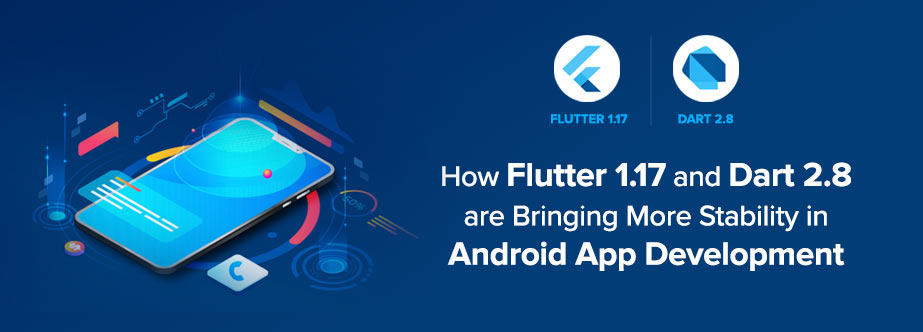How Flutter 1.17 and Dart 2.8 are Bringing More Stability in Android App Development
Google has announced its first stable releases for Flutter and Dart in recent days! Besides resolving previous issues, the Flutter 1.17 and Dart 2.8 version is ready to solve dev puzzle along with material design improvements for web, desktop, and mobile apps.
Read Also: A Quick Guide to Choose the Best Technology Stack for Mobile App Development
Before we get started to share insights into the new versions, let’s put a spotlight on what is Flutter and Dart.
What is Flutter?
An open-source UI cross-platform framework used for creating high-level native interfaces for Android and iOS apps. It includes ready-to-use widgets, development tools, and a rendering engine. Using the elements, developers can design, build, and test your apps.
- Flutter has its engine that allows developers to render apps on both Android and iOS.
- It is a fast and object-oriented programming language.
- In Flutter, Android app developers can build apps using Android Studio or Visual Studio.
What is Dart?
When it comes to an accessible, scalable, and multi-purpose programming language, then any reliable Android App Development Company opts for Dart. Dart is a cross-platform and object-oriented framework that is supported by all major operating systems. It is open-source and available with a BSD license.
- Dart has a strong base with many libraries and tools, enabling Android app developers to make large applications seamlessly.
- It simplifies programming tasks and used to build high-quality real-time applications.
- Being an object-oriented programming language, it supports inheritance, interfaces, and optimal typing features.
Why Flutter Uses Dart?
Do you know, Dart is a big reason developers love using Flutter. Here’s why:
- Dart is Ahead of Time which makes Flutter fast and helps developers to customize everything (including all widgets).
- Dart offers exceptionally fast development cycles along with game-changing workflows.
- Dart makes it easier to create smooth animations and transitions that run at a speed of 60fps.
- Using Dart’s declarative and programmatic layout, Flutter does not need separate declarative layout languages like XML or JSX.
However, all these features are not unique but the combination of them makes Dart powerful for implementing Flutter.
What’s New in Flutter 1.17?
With the latest release of the Flutter framework, Google has almost closed around 6339 issues that occurred in the last release. Besides bug fixes, Flutter 1.17 came up with smart features like assistance for Metal on iOS, big performance improvements, and introduction of new material widgets.
Metal is the low-level graphics API for Apple which makes Flutter-based apps run faster and enables quick deployments of applications on iPads and iPhones. With the latest release, top mobile application development companies in California are thinking to use Flutter to get enhanced Metal support that boosts the execution speed of iOS apps by 50%, based on the workload.
Flutter 1.17 brings more on the table for Google’s Material Design. Various Widgets are updated like Navigation Rail Widget that is amazing for apps that switch between desktop and mobile form factors. TextSelection overflow widget enhances the fidelity for Android and iOS apps and DatePicker Widget adds new visuals while matching the guidelines of the updated material design.
The ultimate focus of this release was to improve mobile app performance and enhance its sizes. With Flutter 1.17, users can experience smaller apps, faster animations, and lower memory usage. With 70% memory reduction in quick scrolling, the apps can yield optimum performance based on the quantity of the device’s memory.
The latest release has also fixed accessibility issues. With an upgrade, Android app developers can check for accessibility fixes for scrolling, text fields, and other input widgets.
With the introduction of MGM and Superformula, Flutter apps use a single codebase for iOS and Android, unlock exceeded speed & flexibility, and maximize cross-team collaboration.
What’s New in Dart 2.8?
There are around millions of Flutter developers that are using Dart for building fast apps on any platform. Google introduces new features to make developers more productive while managing dependencies.
In this release of Dart 2.8, almost all the enhancements are focused to improve pub client tools that are used for handling app packages. Android app developers can optimize the performance of the app using the pub tool. Moreover, it brings changes in the Dart language and libraries to build, a higher quality package ecosystem.
Support for the Sound Null Safety feature is one of the big achievements in this release. Null references are a basic source of app crashes and it occurs when code attempts to read variables that have null values.
Summary
As both Google’s releases seem more stable and promising than ever before. Flutter 1.17 along with Dart 2.8 will commonly be used to build robust apps for diverse application development platforms. With all the power and capabilities, both of them will have a strong presence in the market for developing intuitive apps for large-scale businesses.
